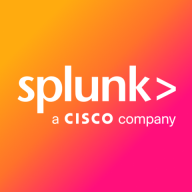

Splunk Enterprise Security and DNIF HYPERCLOUD compete in the SIEM category. Splunk appears to have the advantage due to its advanced features and integration capabilities, appealing to large enterprises seeking robust security solutions.
Features: Splunk Enterprise Security offers robust data integration, visualization capabilities, and advanced threat detection, including Risk-Based Alerting and User Behavior Analytics. Its Mission Control and customizable dashboards enhance security management for large enterprises. DNIF HYPERCLOUD provides SQL/DQL search capabilities, efficient multi-cloud management, and essential compliance features, focusing on budget-conscious environments.
Room for Improvement: Splunk could enhance its GUI, simplify operational workflows, and improve integration flexibility. Its complex pricing model is another challenge. DNIF HYPERCLOUD needs to address GUI improvements, export limits, and integration, especially in threat management. It also faces scalability issues and complexity with machine learning plugins.
Ease of Deployment and Customer Service: Splunk supports flexible deployments across Public, Private, and Hybrid Clouds with extensive documentation and community support. However, complexities in setup and support response times can be problematic. DNIF HYPERCLOUD offers straightforward deployments at competitive pricing but relies heavily on backend support, potentially delaying issue resolutions. Its customer service is competent in simpler environments but could benefit from documentation improvements.
Pricing and ROI: Splunk's high pricing reflects its premium features, offering significant ROI for enterprises maximizing its capabilities, though smaller businesses may find it cost-prohibitive. DNIF HYPERCLOUD provides an economical pricing model based on log volume, appealing to budget-conscious firms. While it delivers substantial value, infrastructure demands could impact ROI.
| Product | Market Share (%) |
|---|---|
| Splunk Enterprise Security | 8.7% |
| DNIF HYPERCLOUD | 0.6% |
| Other | 90.7% |


| Company Size | Count |
|---|---|
| Small Business | 3 |
| Midsize Enterprise | 1 |
| Large Enterprise | 3 |
| Company Size | Count |
|---|---|
| Small Business | 110 |
| Midsize Enterprise | 50 |
| Large Enterprise | 257 |
DNIF HYPERCLOUD is a cloud native platform that brings the functionality of SIEM, UEBA and SOAR into a single continuous workflow to solve cybersecurity challenges at scale. DNIF HYPERCLOUD is the flagship SaaS platform from NETMONASTERY that delivers key detection functionality using big data analytics and machine learning. NETMONASTERY aims to deliver a platform that helps customers in ingesting machine data and automatically identify anomalies in these data streams using machine learning and outlier detection algorithms. The objective is to make it easy for untrained engineers and analysts to use the platform and extract benefit reliably and efficiently.
Splunk Enterprise Security delivers powerful log management, rapid searches, and intuitive dashboards, enhancing real-time analytics and security measures. Its advanced machine learning and wide system compatibility streamline threat detection and incident response across diverse IT environments.
Splunk Enterprise Security stands out in security operations with robust features like comprehensive threat intelligence and seamless data integration. Its real-time analytics and customizable queries enable proactive threat analysis and efficient incident response. Integration with multiple third-party feeds allows detailed threat correlation and streamlined data visualization. Users find the intuitive UI and broad compatibility support efficient threat detection while reducing false positives. Despite its strengths, areas such as visualization capabilities and integration processes with cloud environments need enhancement. Users face a high learning curve, and improvements in automation, AI, documentation, and training are desired to maximize its potential.
What Are the Key Features of Splunk Enterprise Security?In specific industries like finance and healthcare, Splunk Enterprise Security is instrumental for log aggregation, SIEM functionalities, and compliance monitoring. Companies leverage its capabilities for proactive threat analysis and response, ensuring comprehensive security monitoring and integration with various tools for heightened operational intelligence.
We monitor all Security Information and Event Management (SIEM) reviews to prevent fraudulent reviews and keep review quality high. We do not post reviews by company employees or direct competitors. We validate each review for authenticity via cross-reference with LinkedIn, and personal follow-up with the reviewer when necessary.